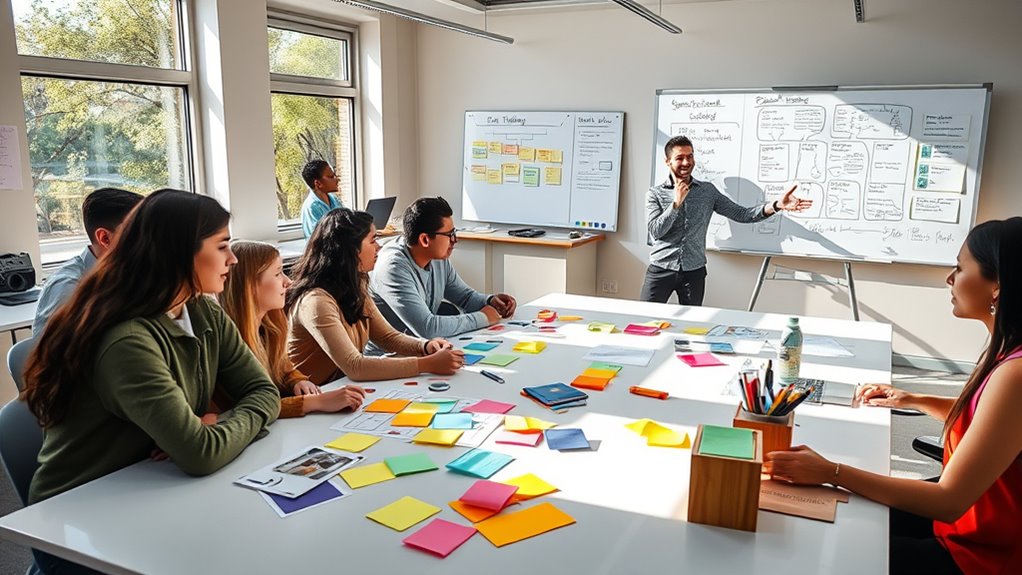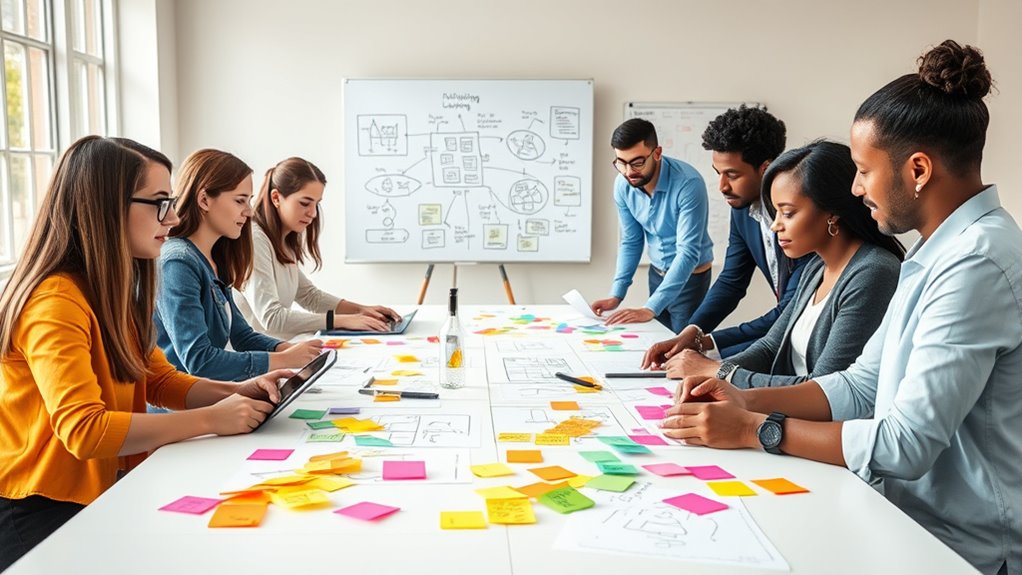To unlock intrinsic motivation in learning and development, apply design thinking by empathizing with learners to understand their needs and challenges. Focus on creating personalized experiences that foster autonomy, mastery, and purpose. Use experimentation with techniques like gamification and social collaboration to engage learners deeply. Continuously gather feedback and refine your approach, ensuring your strategies stay relevant. Keep exploring these methods further to unlock even greater engagement and motivation.
Key Takeaways
- Use empathy to understand learners’ intrinsic drivers, tailoring experiences that align with their purpose and passions.
- Incorporate creative, learner-centered design principles to foster meaningful challenges and personal growth.
- Integrate gamification, social collaboration, and engaging techniques to boost internal motivation and active participation.
- Establish continuous feedback loops for iterative improvement, ensuring learning solutions remain relevant and motivating.
- Promote autonomy and mastery by providing personalized, purposeful tasks that inspire a sense of achievement.
Understanding Intrinsic Motivation in the Workplace

Have you ever wondered what truly drives employees to excel beyond just financial rewards? It’s often intrinsic motivation—an internal desire to find purpose and satisfaction in work. When employees experience employee autonomy, they feel trusted to make decisions and manage their tasks, which boosts their sense of ownership. This autonomy fuels intrinsic rewards like personal growth, mastery, and a sense of achievement. Instead of relying solely on external incentives, you can foster environments where individuals feel empowered to pursue meaningful challenges. Recognizing and nurturing these internal drivers encourages sustained engagement and creativity. When employees find purpose in their work, they’re more likely to go above and beyond, leading to improved performance and a more motivated, fulfilled workforce. Exploring diverse genres in storytelling can also inspire creativity and innovation within teams.
The Principles of Design Thinking in Learning Environments

Design thinking offers a powerful framework for creating effective and engaging learning environments by prioritizing empathy, experimentation, and iterative improvement. At its core, it emphasizes user-centered design, ensuring that learning experiences meet learners’ needs and preferences. You foster creative collaboration by encouraging diverse ideas and perspectives, which sparks innovation and problem-solving. This approach helps you prototype solutions quickly, gather feedback, and refine your methods continuously. By applying these principles, you create adaptable, personalized learning experiences that boost motivation and engagement. Remember, the focus is on understanding learners deeply, co-creating solutions, and improving based on real-world insights. This iterative process keeps the environment dynamic, responsive, and aligned with learners’ evolving needs and goals. Attention to detail from quality assurance principles can help ensure that each stage of the design process is thorough and effective.
Empathizing With Learners to Personalize Educational Experiences

To truly personalize educational experiences, you must deeply understand your learners’ motivations, challenges, and preferences. Learner empathy is essential here—it allows you to see the world from their perspective, uncovering what drives their engagement and where they face obstacles. By actively listening and observing, you gather insights that inform tailored approaches. This focus on personalized learning ensures that content and delivery methods align with individual needs, making the experience more relevant and motivating. When you empathize with your learners, you create a foundation of trust and connection, which boosts their intrinsic motivation. Additionally, understanding legal procedures involved in processes such as getting a divorce can inform how you approach sensitive topics within educational contexts. Ultimately, understanding your learners on a deeper level empowers you to design educational experiences that resonate, inspire, and foster meaningful growth.
Ideating Innovative Strategies to Engage and Motivate

What innovative strategies can you employ to truly engage and motivate your learners? One effective approach is integrating gamification techniques that turn learning into a fun, interactive experience. Use points, badges, or leaderboards to foster healthy competition and reward progress, making tasks feel more engaging. Additionally, encourage peer collaboration, where learners work together to solve problems or share insights. This not only boosts motivation through social connection but also fosters a sense of community and shared purpose. Incorporating sound therapy techniques can further enhance focus and emotional engagement during learning sessions. By combining gamification techniques with opportunities for peer collaboration, you create an environment that taps into learners’ intrinsic motivation. These strategies motivate learners to participate actively, sustain interest, and develop a deeper commitment to their growth.
Implementing and Refining Learning Solutions Through Iteration

Building on engaging learners through innovative strategies, the next step is to implement those solutions effectively and refine them over time. You do this by establishing feedback loops that gather insights from learners and facilitators. Use this feedback to identify what works and what needs adjustment, fostering a cycle of continuous improvement. Regularly analyze data and observe learner responses to refine your approach, ensuring your solutions stay relevant and impactful. Iteration isn’t about perfection from the start but about evolving based on real-world results. By embracing this mindset, you create a dynamic learning environment that adapts to learners’ needs, deepening motivation and engagement. This ongoing refinement helps embed intrinsic motivation, making learning more meaningful and sustainable. Additionally, considering divorce guidance principles like clear communication and ongoing assessment can serve as metaphors for refining learning strategies effectively.
Frequently Asked Questions
How Can Intrinsic Motivation Be Measured Effectively?
You can measure intrinsic motivation effectively by focusing on motivation metrics and engagement indicators. Track how often and how deeply learners participate, noting their enthusiasm and persistence. Use surveys and self-report tools to gauge their internal drive, and observe behaviors like curiosity and effort. Combining quantitative data with qualitative insights helps you understand their genuine motivation levels, allowing you to tailor learning experiences that foster ongoing internal interest.
What Are Common Barriers to Fostering Intrinsic Motivation?
Imagine a garden where you’re trying to grow true motivation. Barriers like relying on extrinsic rewards or seeking peer recognition are like weeds choking the soil. These external factors distract you from your inner passion. Without nurturing curiosity and autonomy, intrinsic motivation struggles to blossom. To foster genuine drive, you need to clear these weeds, focusing instead on meaningful engagement and personal growth that truly energize your learning journey.
How Does Culture Influence Intrinsic Motivation in Learning?
Culture shapes your intrinsic motivation by influencing your values and what you find meaningful. Cultural values set the foundation for what motivates you internally, while motivational norms guide how you pursue learning. If your environment emphasizes personal growth and curiosity, you’re more likely to stay engaged. Conversely, cultures that prioritize external rewards may diminish your internal drive. Understanding these influences helps you tailor learning experiences that resonate with your cultural context.
Can Intrinsic Motivation Be Cultivated in Adults Effectively?
You can definitely cultivate intrinsic motivation in adults through effective self-determination and motivation strategies. When you tap into their autonomy, competence, and relatedness, you foster genuine interest and engagement. Adults respond well to personalized learning experiences that align with their goals. By creating a supportive environment and encouraging self-reflection, you help them develop internal motivation, making learning more meaningful and sustainable over time.
What Role Does Technology Play in Enhancing Motivation?
Technology plays a vital role in enhancing motivation through gamification strategies and interactive design. You can leverage these tools to create engaging, personalized experiences that boost intrinsic motivation. By incorporating game elements like rewards and challenges, you make learning more enjoyable. Interactive design encourages active participation, making learners feel more connected and invested. Ultimately, technology helps you foster a motivating environment where adults stay engaged and enthusiastic to learn.
Conclusion
By applying design thinking to learning and development, you can uncover intrinsic motivation and create personalized experiences that resonate. Remember, “Rome wasn’t built in a day”—it takes continuous empathy, innovation, and refinement to truly inspire learners. Keep experimenting, listen to feedback, and adapt your strategies. With patience and persistence, you’ll develop engaging solutions that motivate from within, turning learning into an exciting journey rather than a chore.









